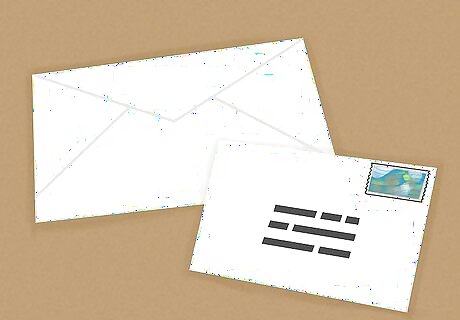
views
X
Research source
[2]
X
Research source
Negotiating with the Other Party

Assess the value of the domain. Before you attempt to contact the current domain holder, do a little research to determine the domain's potential traffic impact and how it could improve your marketing and branding. This assessment assumes you don't currently have a trademark on a word or words included in the domain name. Having a trademark puts you on stronger footing against the current domain holder, but it also could mean that the domain is being held by a cybersquatter who's only trying to extract maximum value by snapping up the domain before you could get to it. Look at the potential for confusion between the domain and any other domain you currently own. For example, suppose you currently own candyscupcakes.net, the website for your business called Candy's Cupcakes. If someone else owns candyscupcakes.com, there's a pretty significant likelihood that a potential customer trying to find your website would land there instead. Evaluate the website's page rank or rating on performance metrics such as Google page rank and Alexa page rank. These algorithms give you a good idea of the website's performance and recognition level on the internet. If the domain gets high search results, it potentially is worth a larger investment. Based on your analysis, come up with a range you're willing to spend to purchase the domain from the individual or business currently holding the domain. You may want to consider hiring a domain broker to do this analysis for you, particularly if you have little to no experience with domain valuation and web marketing. Most domain registrars offer broker services.

Find out who currently holds the domain. Before you can negotiate with the person who currently owns the domain, you must find out his or her name and contact information. You can use the WHOIS utility to look up the person who has registered the domain name. Go to the website www.whois.net, and type the exact web address. With a few clicks, you can find out the registrant's name as well as administrative, technical, and billing contacts. WHOIS also tells you when the domain was originally registered and when the registration is due to expire. Sometimes you may not be able to get actual names and contact information because the domain holder has contracted for domain name privacy, typically through his or her registrar. If instead of an individual's name you see the name of a domain privacy company or a registrar, you'll have to take the extra step of going through them to get contact information about the registered owner of the domain. If the domain currently is active, spend a little time perusing the site. Get to know the owner and his or her business. See if you can figure out the connection between the business and the domain name. If there seems to be little connection, it may be a signal that the owner isn't extremely attached to the domain name and would be willing to sell it to you. If the domain owner only appears to be holding it as an investment opportunity, this potentially gives you more room to negotiate. A domain name can be purchased relatively cheaply, and the only chance the owner has to profit from this meager investment is to sell it. If you can convince the domain owner that you are the best, or only, potential buyer of the domain name, you stand to get it at a fairly reasonable price.

Send a letter to the domain holder. Once you have contact information for the registered domain holder, craft an exploratory business letter expressing your interest in the domain and asking whether the holder would consider selling it. Write your letter in standard business format, and keep your language polite and professional. If you have letterhead that includes a word or words in the domain that you want to buy, this may help reinforce your claim. Your letter should be brief. You don't need to provide any background information about yourself or your business, or why you are interested in the domain. Simply state that you are interested in purchasing the domain name, and give the holder the lowest possible amount you are willing to pay based on your research. Take care that the price isn't low enough to insult the holder and cause him or her to reject your offer outright. However, you should assume the holder will reply with a higher number, so give yourself plenty of room to maneuver. Sign your letter and provide your email address and phone number for the domain holder to get in contact with you.

Evaluate the response. Depending on how the domain holder responds to your initial foray, you may be able to resolve the domain name dispute between yourselves without filing a complaint or a lawsuit. You may want to introduce some urgency into the exchange. Explain that you have a deadline, or that your boss wants the transaction completed quickly. Neither of these may be true, but if it's nothing the holder could find out about, it shouldn't be any issue. Keep in mind that it's possible the domain holder may come back at you with a ridiculously high amount that's far away from even the maximum you were willing to pay. Stay firm, and provide a counter-offer not much higher than your original lowball. If the domain holder wasn't at all interested in selling the domain, he or she wouldn't still be talking to you.

Demonstrate a willingness to compromise. Have respect for the domain holder's business and his or her interests in the domain, approaching negotiations with caution but also with flexibility. While you never want to give up your range, or valuable information about exactly how important the domain is to you, there are still ways you can demonstrate flexibility to even the toughest negotiator. For example, if the domain holder comes back with a number that's still far away from yours, you might say something like "I can see that we're still very far apart, but I believe we can find common ground." Consider giving the domain holder a false maximum, especially if you've already gone through a couple of rounds of negotiations. For example, suppose you've offered $1,500, and the domain holder said he was willing to sell for $7,000. After a couple rounds of negotiations, you've got him down to $6,000, and you're currently at $1,800. If you tell the domain holder "I can go as high as $3,000, but that's the absolute most I have in my budget," he may be willing to come down to that level or close to it. At this point, you may even be able to close the sale for under the $3,000 you set as your "ceiling," which is quite a boon to you if you budgeted $5,000 to purchase the domain.
Filing a UDRP Complaint

Gather information about the domain and your trademark. Before you fill out a UDRP complaint, you must have information about the current domain holder and the reason you believe it should be transferred to you. You should download and read the UDRP so you understand what factual and legal grounds are considered acceptable grounds for filing a complaint. You can find a downloadable copy by visiting the website of the Internet Corporation for Assigned Names and Numbers (ICANN). You generally don't need an attorney to file a UDRP complaint. However, if you find yourself getting confused or too bogged down with the grounds for your complaint, you might consider consulting an attorney who specializes in domain name disputes and getting an opinion on your case and advice on how to proceed. Typically a claim to a domain over someone else who's already registered it relies on the ownership of intellectual property in a word or words contained in that domain. For example, suppose you have invented a board game called "Cupcake World." You manufacture and distribute the game, and also have a trademark in the game's name. However, when you go to register the domain for cupcakeworld.com, you find it is already owned by a bakery. To file a complaint under the UDRP, you would need information about your trademark as well as information about the bakery and the individual who had registered the domain.

Choose an arbitration provider. There are at least four ICANN-approved organizations that can accept UDRP complaints and provide mediation. Each of these organizations charges different fees and has different supplemental rules that apply to its arbitration proceedings. Arbitration providers include the World Intellectual Property Organization (WIPO), the National Arbitration Forum (NAF), the CPR Institute for Dispute Resolution (CPR) and the Disputes.org/eResolutions Consortium (DEC). Each of these providers has supplemental rules that you should review before you decide which one you want to use. While some have higher fees than others you shouldn't base your decision entirely on fees. For example, while DEC has the lowest fees, it limits your complaint to 1200 words, or about 1.5 pages. In contrast, WIPO limits a complaint to 5,000 words, while NAF and CPR allows complaints up to 10 pages long. Fees for arbitration may be as little as $750 (one domain reviewed by a single panelist at DEC) or as much as $6,000 (3-5 domains reviewed by a three-member panel at CPR).

Complete and file a UDRP complaint with your chosen arbitration provider. Once you've chosen an arbitration provider, you typically can fill out a complaint form online at the organization's website and submit it once you've filled it out. Under the UDRP, you must prove that you own a trademark (either registered or unregistered) which is the same or deceptively similar to the registered domain name, that the current domain holder has no legitimate right or interest in the domain name, and that he or she registered and used the domain name in bad faith. If you are not able to successfully prove all three points, the panel will not cancel or transfer the domain name. In addition to completing the online application, you may have to submit hard copies to your chosen provider. Your application should include your name, email address, mailing address, telephone, and fax numbers, and indicate your preferred means of communication. You can choose whether to have a single member or three-member panel review your complaint. If you choose a three-member panel, you are allowed to list up to three candidates to serve as one of the panelists. A three-member panel typically is made up of one member you've chosen, one member the respondent has chosen, and one member chosen by the arbitration provider. If you have a registered trademark, you should attach a copy of it to your complaint. It doesn't need to be a certified copy – a photocopy is sufficient. After you've established the factual and legal grounds for the complaint, you must specify the remedy you seek. You can either request the domain be cancelled or that the domain be transferred to you. The UDRP does not permit you to seek fines or punitive damages. Remember to fill out the complaint form completely and pay the required fees. Once you submit it, your chosen provider will review it for completeness. If it is judged incomplete, it will be returned to you and you will have five days to complete it or the complaint will be dismissed.

Evaluate the response from the domain holder. After your arbitration provider has determined your complaint form is compliant, it will forward a copy of your complaint to the respondent and the domain's registrar within three days. The current domain holder – now called the "respondent" of your complaint – has 20 days to file a response. If the respondent does not file a response by the deadline, you may be eligible to win your complaint by default. The response must respond specifically to the statements and allegations you made in your complaint. The respondent also may include any and all reasons he or she should be allowed to retain registration of the disputed domain name. There are three defenses the respondent can assert that, if proven, will bar cancellation of the domain name or transfer to you: use of the domain name in connection with a bona fide business, legitimate non-commercial or fair use of the domain name, or proof that the respondent is commonly known by or associated with the domain name (even if he or she has no trademark rights in it). Even if you chose a single-member panel, the respondent can request a three-member panel. In this case, you and the respondent must split the fees for the arbitration evenly. Otherwise, you bear the costs. The UDRP does not provide for recovery of these fees from the respondent, even if you win.

Receive notice of the arbitration panel's decision. After your arbitration provider has received the respondent's response, it has five days to appoint a panel to evaluate the dispute and come to a decision. After the panel has been appointed, it has 14 days to reach a decision. Then, the panel has three days to notify all parties of its decision. If the panel's decision is not in your favor, your only recourse is to file a lawsuit. The registrar must implement the panel's decision after 10 business days, unless a lawsuit has been filed. Keep in mind that this same right of appeal to federal court exists for the respondent as well. Even if you win your complaint, the respondent may file a lawsuit within 10 days of notice of the panel's decision.
Going to Court

Gather information about the dispute. If you've filed a complaint with an ICANN-approved provider under the UDRP, the same information you used to complete your complaint form can be used to initiate a lawsuit against the domain holder in federal court. Keep in mind that the UDRP is not exclusive, and you don't have to attempt to resolve your dispute under the UDRP before you pursue traditional litigation. However, if you've already submitted a UDRP complaint, it's best to let it run its course before you file a lawsuit, as the entire process will be completed in less than two months. The arbitration panel can suspend or terminate proceedings if you file a new lawsuit before it has reached a decision. Generally, you cannot sue over a domain name dispute unless the domain infringes on a registered trademark that you own. You may have additional recourse under the federal Anticybersquatting Consumer Protection Act, but you must be able to show that the current domain holder acted in bad faith when he or she registered the domain. You also must have a trademark that predates the registration of the domain name by the current domain holder.

Hire an attorney. Because domain dispute law and federal court rules and procedures are complex, if you get to the point where you've decided to file a lawsuit, hiring an attorney with experience litigating domain dispute cases is essential. Larger intellectual property law firms typically have a department that handles internet issues and domain name disputes. If you've already consulted an attorney at other points regarding your situation, you may want to go ahead and retain the same attorney, since he or she already has at least a passing familiarity with your case. If you've not already consulted an attorney, look for someone who specializes in domain name disputes and also has experience in trademark litigation – since a domain name dispute lawsuit essentially is a trademark infringement lawsuit.

File a complaint. Your attorney will work with you to build the allegations that will form the basis of your lawsuit, then file it with the federal district court that has jurisdiction over your domain name dispute. All complaints must be accompanied by a $400 filing fee. Typically, you will be responsible for paying this, unless your attorney has agreed to work under a contingency fee agreement (which is rare in intellectual property cases). Once the complaint is filed, the clerk assigns it to a judge at random and gives it a case number, which will be used on all other documents filed with the court in your case. You must have the other party served with a complaint and summons so he or she has legal notice of the lawsuit. This typically is done either by having the documents hand-delivered by a U.S. Marshal, or by sending them using certified mail with return receipt requested. After the other party has been served, he or she has 21 days to file an answer or other response to your lawsuit. If the domain holder misses this deadline, you may be eligible to win your lawsuit by default – but don't expect this to happen.

Engage in pretrial litigation. Assuming the domain holder has filed an answer, the discovery phase of pretrial litigation begins. You and the domain holder will exchange evidence and information related to the domain name dispute. The first form of discovery you likely will use or encounter typically will be written discovery in the form of interrogatories (written questions) and requests for production. These documents will be delivered to your attorney and must be answered in writing under oath. You also will have the opportunity to participate in depositions, which are interviews conducted under oath in the presence of a court reporter. The court reporter then produces a transcript of the proceedings. Both parties likely will want to depose each other. Keep in mind that the discovery process can take months, if not years. The court likely will hold a number of scheduling conferences for the purpose of keeping the litigation on track and setting deadlines for the completion of certain tasks.

Consider attempting mediation. Because lawsuits can take years to even reach trial, working with a mediator may help you settle the domain name dispute in a quicker and more cost-efficient way. Many district courts have their own mediation programs available to civil litigants for free or at a substantially reduced cost. Through mediation, a neutral, third-party individual trained in dispute resolution works with you and the other party to facilitate a settlement to the dispute. The mediation proceedings are confidential and non-binding. There is no requirement that you resolve your domain name dispute. However, if you and the other party do reach a settlement, the terms of that agreement can be put in writing and signed by both parties to create a legally binding contract.




















Comments
0 comment